
Usage of TPR for Contemporary History
Educational Level
Upper Secondary
Student Age
14 – 18
Number of students
activity with the whole classroom
Lesson duration
2 hours
- Gain a deeper understanding of contemporary history through the use of telepresence robots.
- Increase access to contemporary historical events through the involvement of contemporary witnesses.
- Foster a greater sense of connection to contemporary historical events by providing opportunities to interact with witnesses and explore historical sites.
- Develop skills in using telepresence technology to facilitate learning and engagement with historical events.
- Encourage critical thinking and analysis of contemporary historical events through discussions and activities facilitated by telepresence robots.
- Build empathy and understanding of different perspectives through interactions with witnesses and historical sites.
- Promote the importance of preserving and sharing contemporary history for future generations.
- Create opportunities for interdisciplinary learning by incorporating multiple subject areas such as history, technology, and communication.
- Increase engagement and interest in contemporary history among students and the broader community through innovative and interactive learning experiences.
- Encourage collaboration and teamwork in exploring and interpreting contemporary historical events through the use of telepresence robots.
Improvement in classical examinations on the subject matter according to the curriculum.
Ask question to students regarding self-evaluation if a deeper understanding of the subject and increased interest was developed due to the use of TPR and contemporary witnesses.
Necessary infrastructure to make teleconferencing software and TPR usable.
In this scenario, a contemporary witness would be invited via the TPR to talk about the respective historical chapter. (For example, World War 2; Cold War, unification of Germany, etc.).
Case-Based Learning
Lesson Plan
Before the Lesson:
Teacher
Provides material list and work assignment
Students
Goes through the material and considers a question to the contemporary witness.
Lesson:
Teacher
This scenario is kept very generic, so the exact plan is up to the teacher. We would like to show that the use of TPR can have a high relevance teaching contemporary historical events and also preserving the content for the future if you record the sessions.
Students
Students should first learn about existing materials such as textbooks, movies, or educational games. This is up to the method mix of the respective teacher.
In this phase, the students should write down questions for the contemporary witness.
In the two-hour session, the teacher should give a short lecture on the topic and then the students should present their questions. E.g. on a flip chart or in a digital brainstorming tool if licenses for this are available.
The students should then vote on the questions to be asked of the time-witness.
The witness is invited and gives a presentation. Afterwards, the students whose questions were selected may ask their questions personally.
At the end there is the possibility for a final conclusion of the teacher with his class or in the optimal scenario this is dealt with in a further lesson on the following day and what has been heard is elaborated.
After Lesson:
Teacher
see above
Students
- Evaluate their role in the group.
- Evaluate why they solved the puzzle (or why they failed to do so) and what competences were necessary to do so.
- Evaluate the game design and collect suggestions for improvement.
Media and materials:
–
Author: Alexander Pfeiffer (B & P – Emerging Technologies Consultancy Lab Ltd)
How did this Teaching Scenario work for you?
Have you tried this or a similar Teaching Scenario?
Feel free to share your experiences with a comment below.
Possible questions for your evaluation of the TRinE Teaching Scenario
- What feedback / reflection was provided by the teacher?
- How is the feedback from the students?
- Why did you decide to use TRs?
- How did the TRs inform your lesson plan?
- What shifts or stretches are you making regarding the TRs?
Does the use of the Telepresence robots:
- align to learning outcomes?
- align to assessment?
- support your educational context?
- differentiate for individual students?
- enhance student thinking by addressing different levels of thinking?
- extend learning authentically beyond the classroom?
- increase engagement and active learning?
- promote and support collaboration?
- provide opportunities to construct knowledge?
Are the students participating / motivated / progressing?
Create your Teaching Idea!
1. Read through our TRinE Guide for Teachers to learn more about designing a lesson with a Telepresence Robot. Browse through our TRinE Ideas and get inspired!
2. Download the Word template here to describe and evaluate your teaching scenario.
3. Contact us and send us the form if you want to publish your Teaching Scenario on our website.


0 Comments